Acquisitions: Supporting Contemporary Makers
As the Company moves towards the celebration of its 700th anniversary in 2027, its pioneering support for contemporary makers through competitions, acquisitions and commissioning plays an important part in enhancing the vitality of design and craftsmanship in silver, jewellery and art medals into the 21st century.
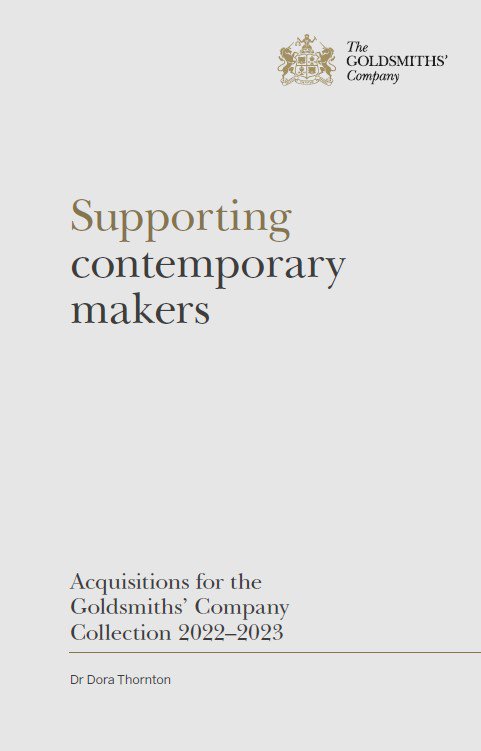
Acquisitions 2022-23
Supporting contemporary makers
This report describes the Company’s acquisitions - gifts, commissions and purchases - over an exciting period, as we continue to digitise our collection. The acquired pieces and gifts help broaden and extend the story of remarkable contemporary jewellery, silver and medals in the Collection.
The Goldsmiths’ Company has supported excellence, craftsmanship, community and skill in the goldsmiths’ community ever since it received its first charter in 1327. That commitment is represented in the Company’s fine Collection of mainly British contemporary and historic plate, modern jewellery and art medals. Our ambitious plans to digitise the Collection will eventually make it freely available online.
A remarkable series of Company commissions was completed during the year, including an innovative Court Cup by Grant MacDonald for Richard Reid; our first Trade Warden’s Badge, designed by Richard Fox; and a superb art medal by Nicola Moss to mark Dr Timothy Schroder’s second term as Prime Warden.
We were proud to see The Late Queen wearing the Company’s gift of a specially commissioned Platinum Jubilee Brooch when she ‘lit’ the first beacon marking her Platinum Jubilee. The Late Queen chose the design herself from a selected shortlist and suggested an additional element that was incorporated in the winning design by David Marshall London. Further acquisitions appropriately celebrated the goldsmith’s art in platinum: Melanie Eddy’s paired faceted rings, sculpture for the body in platinum and silver. Tom Rucker’s impressive pendant featured specially manipulated platinum colour effects and linear laser welding of great delicacy.
There have been generous gifts. Associate Member Helen W. Drutt English presented a fine group of miniature gold sculptures by Breon O’Casey in memory of the artist, and two jewels by the influential American maker, Helen Shirk. Robert A. Hiller gave us two superb pieces by jewellers new to the Collection: a silver brooch by Mirjam Hiller with its precious design model, and an outstanding ring by the late Annamaria Zanella.
Ginnie de Vroomen presented the superb ‘Aurum’ bangle, made to her design as a gift by her husband, Leo de Vroomen. Malcolm Appleby gave us design drawings and two ‘Banchory’ bangles. Rosamond Conway gave us her beautiful designs for her 2008 Company commission. Timothy Came and family presented his late father’s Court Cup by Rod Kelly. The Prime Warden, Lord Bridges, has also given his fine cup by Jane Short and Clive Burr to the Collection.
The Company’s pioneering support for contemporary makers continues to inspire artistry and excellence in precious metal as we move towards our 700th Anniversary in 2027.
Dr Dora Thornton
Curator of the Goldsmiths’ Company Collection
Gift to the Collection: ‘Riflessi Rossi’ (Red Reflections) ring, Annamaria Zanella (1966–2022)
2019, 18 ct gold wire and red translucent and opaque Murano glass
Gift of Robert A. Hiller in honour of Dirk Allgaier and ARNOLDSCHE Art Publishers.
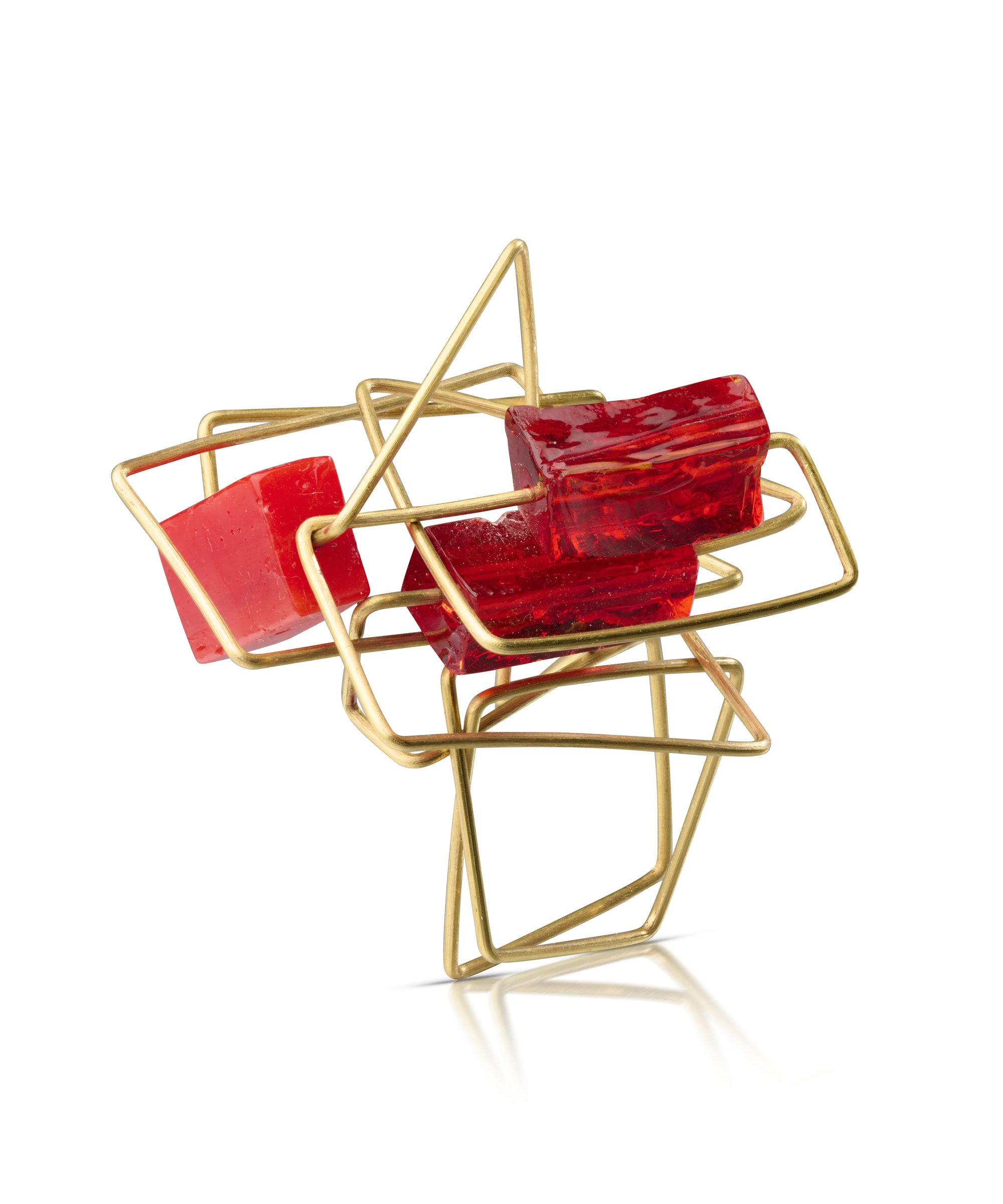
‘Riflessi Rossi’ (Red Reflections) ring, Annamaria Zanella, 2019
"She had designed it according to ‘the harmony of geometry, the divine proportion of mathematics and the Golden Section. A ring that looks chaotic but ... inside it has the golden proportion rule.’"
Robert A. Hiller has also given us the superb architectural ‘Riflessi Rossi’ (Red Reflections) ring by Annamaria Zanella, in honour of Dirk Allgaier and ARNOLDSCHE Art Publishers. It is made from a single length of 18 carat gold wire which has been manipulated into geometric forms with two squared-off shapes to hold the finger. The wire is threaded longitudinally through three beads of bright red Murano glass to make a dramatically different ring.
Zanella graduated from the famous Istituto Statale d’Arte ‘Pietro Selvatico’ in Padua, where she later taught goldsmithing 1987–2000. She was renowned for her accomplishment as a goldsmith; her sense of colour and form; and her ability to transform inexpensive materials into art. Two of her brooches formerly from the Parisian collection of Louise Klapisch are in the Victoria and Albert Museum.
Hiller acquired the ring directly from the maker, shortly before her death in 2022, through a selling exhibition organised by Dirk Allgaier, owner and editor of ARNOLDSCHE Art Publishers in Stuttgart. Allgaier, who has published a book on Zanella and her work, comments on the ring: ‘It is a very extraordinary ring, in its sculptural and architectural and most especially its colourful appeal. I think this is a great addition to the Goldsmiths’ Company jewellery collection.’ Zanella was delighted to know that the ring had joined our Collection, noting that she had designed it according to ‘the harmony of geometry, the divine proportion of mathematics and the Golden Section. A ring that looks chaotic but ... inside it has the golden proportion rule.’
Commission: The Platinum Jubilee Brooch, David Marshall London
2022, 18 ct white gold, platinum, 97 round brilliant cut 2.50 ct diamonds and 7 fancy cut 0.40 ct diamond
Designed by Denise Gibbs; 3D CAD by Simon Wolfberg; cast by Design Build Cast, mounted and set by Matt Martin, Madeline Rowe, Mark Moutia and Craig Michel of The London Art Works.

The Platinum Jubilee Brooch, David Marshall London, 2022
Commissioned by the Goldsmiths’ Company as a gift to mark Her Late Majesty’s Platinum Jubilee. The design was handpicked by the Late Queen from a selection submitted by a shortlist of highly-acclaimed UK jewellery makers. The brooch was inspired by the four nations of the United Kingdom, England, Scotland, Wales and Northern Ireland, represented by four diamond-set swirls and the national flowers: the rose, the thistle, the daffodil and the shamrock. Seven diamond-set bands represent seven decades of royal service. Buckingham Palace proposed the addition of the lily of the valley given its significance in The Late Queen’s Coronation bouquet.
The brooch was made by a team of specialists at The London Art Works using a combination of traditional and contemporary techniques, from the lost wax casting process to computer aided design (CAD). We were delighted when The Late Queen wore her brooch on 2nd June 2022 to light the first in a chain of Jubilee Beacons, an event which attracted global media coverage. This is the duplicate brooch (marked ‘No. 2’ on the reverse) which was made for the Company Collection. It bears the Platinum Jubilee commemorative mark, designed by Thomas Fattorini Ltd, which depicts an orb in reference to the traditional fineness mark for platinum.
Purchases: Brooch, Gill Galloway-Whitehead
2020, Fine silver and sterling silver, 24 ct gold, 18 ct gold, and 9 ct gold and stainless steel pin
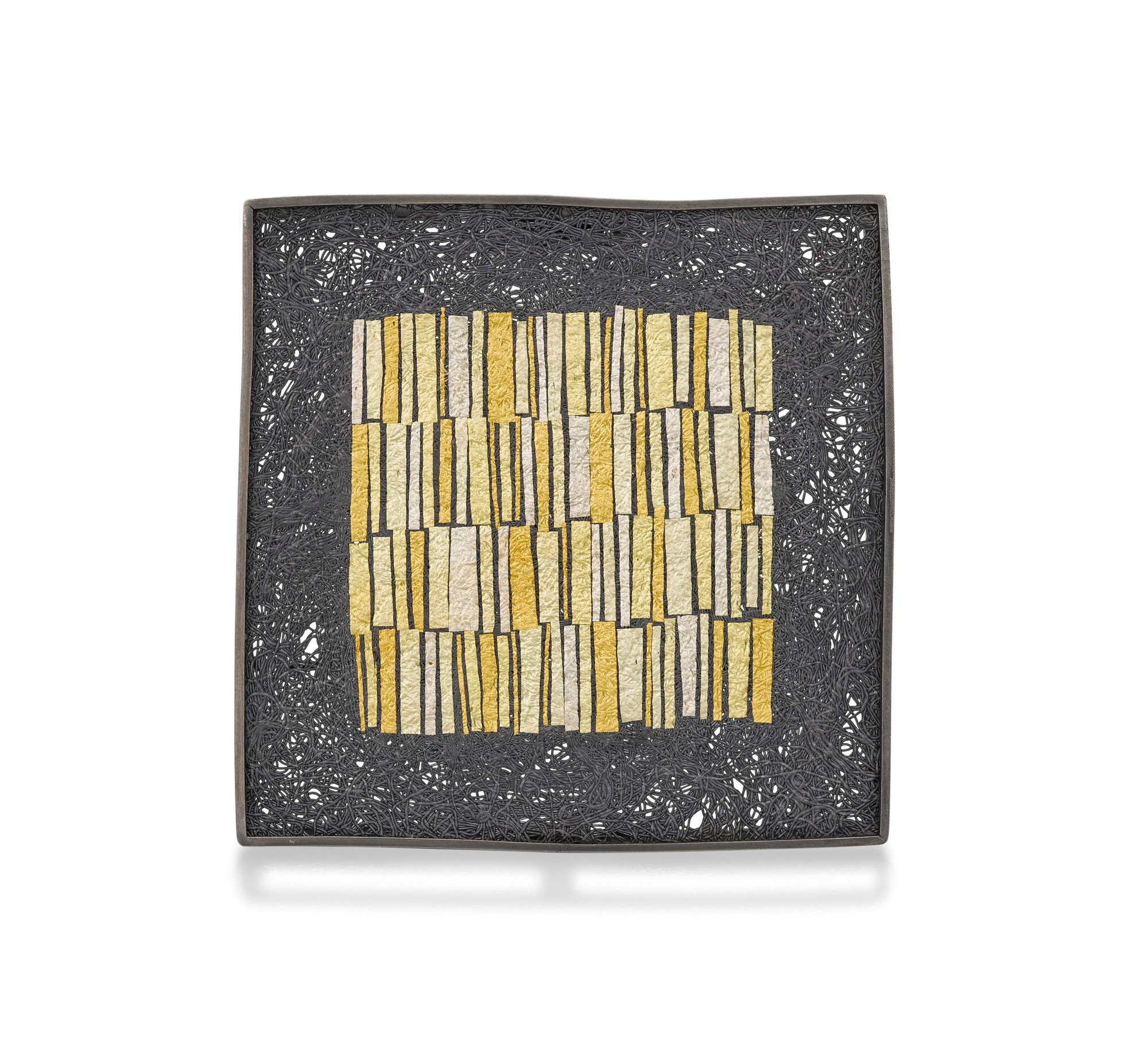
Brooch, Gill Galloway-Whitehead, 2020
Galloway-Whitehead works in fine precious metal wire, making her own gold alloys which she then adds to a base layer of silver wire to create fascinating textures and colours all her own. The inspiration for the brooch derives from the work of Anni Albers, student and teacher at the Bauhaus. The pattern is built up of repeated shapes of gold, varying in tone, which create a subtle texture. She quotes Albers in listening here to ‘the dictation of materials.’ The result is something very different from her earlier, more painterly brooches in the Collection, which draw on the landscape of the Northeast of England where she lives and works.
Purchases: ‘Conjunction: Two Circles’, Juliette Bigley
2022, Stainless steel and sterling silver
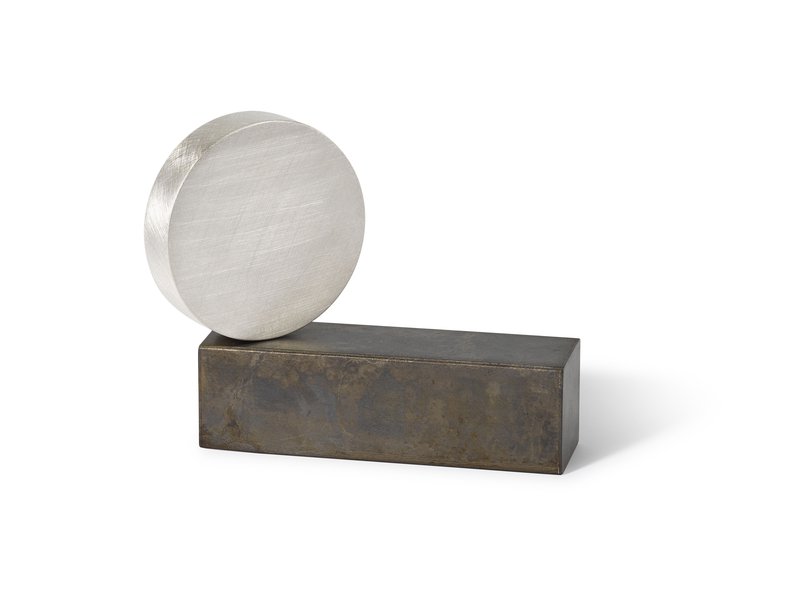
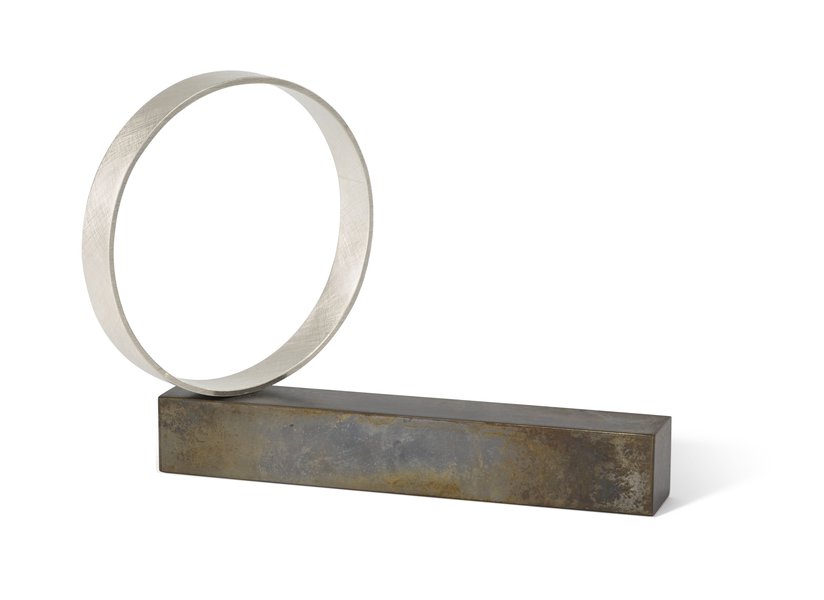
"Her sculptures have their own lives, as each viewer is free to project their own meaning, and to form their own attachment to them."
Juliette Bigley’s abstract sculpture ‘Conjunction: Two Circles’ was an important acquisition from Goldsmiths’ Fair 2022. This was the year the Fair celebrated its fortieth anniversary with an exhibition featuring forty significant pieces from the Collection including sculptural, experimental and abstract metalwork by leading contemporary silversmiths. Bigley’s sculpture is in this tradition.
It is in two parts: a large silver hoop is fixed towards one end of a flat, hollow cuboid bar of patinated stainless steel; a smaller hollow silver sphere is fixed, similarly off-centre, to a second, shorter steel bar. Both silver elements are held with a pin, so that they can revolve upon their bases. The sculpture is part of a ‘Conjunction’ series of works produced for the 2022 Fair, every piece of which incorporates an element of movement. Bigley states that it is as she solders the form, as the 2D turns to the 3D, that the ‘magic comes’.
Bigley describes her reasons for making with eloquence: ‘I make to understand how the world fits together. The way in which our internal experiences interact with the physical world is the stuff of our lives… and yet we have very little understanding of how the material and immaterial aspects of our experience interrelate… Making, which by its nature combines idea with material, is a microcosm of this relationship, and is the focus of my practice.’ Her sculptures have their own lives, as each viewer is free to project their own meaning, and to form their own attachment to them; ‘I like to leave a space in my work for people to find a little bit of their own self.’